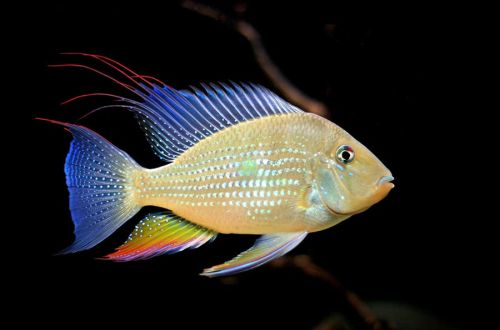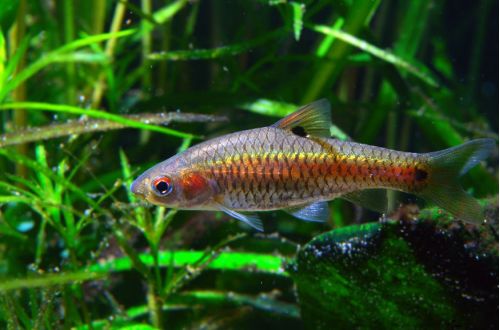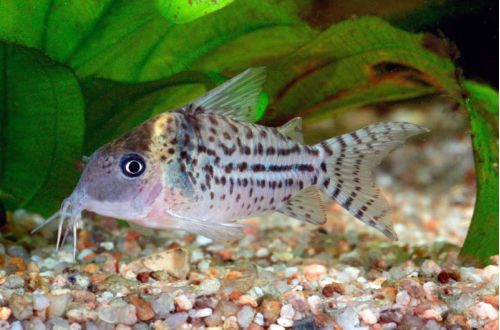
Threaded Akara
Akaricht Haeckel or Carved Akara, scientific name Acarichthys heckelii, belongs to the Cichlidae family. Beautiful, bright and relatively easy to keep fish with unusual behavior during the breeding season. In a spacious aquarium, it will not cause much trouble to its owner.

Contents
Habitat
It comes from South America, mainly from the northern part of the Amazon Basin from the territory of Colombia, Peru and part of Brazil. Inhabits numerous rivers and streams flowing through tropical rainforests. During the rainy season, as the water level rises, it swims into the flooded areas of the Amazon forest.
At present, it has been brought to Southeast Asia (Singapore region), where it has successfully taken root.
Brief information:
- The volume of the aquarium – from 300 liters.
- Temperature – 24-30°C
- Value pH — 6.0–7.0
- Water hardness – 1–12 dGH
- Substrate type – sandy
- Lighting – subdued
- Brackish water – no
- Water movement – little or no
- The size of the fish is about 20 cm.
- Food – any food
- Temperament – conditionally peaceful
- Content in a pair or group
Description

Adult individuals reach a length of about 20 cm. Females are larger, males, in turn, are brighter colored. The body is beige with rows of blue speckles. The tail and dorsal fin are blue and have elongated filiform outer rays. The ventral and anal fins combine all the colors of the rainbow.
Food
An omnivorous species, it will accept various foods popular in the aquarium trade, such as dry flakes, granules, frozen or live bloodworms, daphnia, brine shrimp. Herbal supplements are mandatory, such as spirulina or blanched pieces of spinach, lettuce, etc. Otherwise, the fish will damage the aquatic plants in the aquarium (if any).
Maintenance and care, arrangement of the aquarium
A tank of 300 liters is enough for two fish, and more than 1000 liters may be required for a flock of Threaded Acar. The design uses sandy soil, several snags in the form of roots or branches of trees. The lighting is subdued. Fish tend to dig in the ground, so the “landscape” can change a lot. For the same reason, rooted plants are not recommended. If desired, you can use floating shade-loving plants, as well as aquatic mosses and ferns that are attached to the surface of snags.
Successful long-term keeping is entirely dependent on maintaining high water quality. Fish are not tolerant of the accumulation of organic waste and products of the nitrogen cycle, therefore, along with standard maintenance procedures, weekly replacement of part of the water (50–70% of the volume) with fresh water and the installation of a productive filtration system, preferably from external filters, are mandatory. When choosing a specific model and the place of its placement / fastening, you should consult with specialists. The filter must provide good cleaning, not cause excessive movement of water, and also resist clogging with sand that can get into it when the fish dig in the ground, creating a cloud of suspension.
Behavior and Compatibility
Relatively peaceful calm fish, in adulthood, behavior can be unpredictable. It all depends on external factors: the volume of the aquarium and the number of fish. In a small tank, the risk of aggression is higher, the more fish it contains. Accordingly, there are practically no problems in spacious aquariums. In relation to other species, the Threaded Akara is safe if they are large enough not to fit in her mouth.
Breeding / breeding
Breeding in a home aquarium is unlikely. The main reason is the need to simulate the conditions occurring in nature: the rise and fall of the water level, the corresponding change in temperature and hydrochemical composition. All this serves as an incentive for reproduction. In addition, fish are characterized by unusual behavior during spawning, associated with the construction of a nest – a laying place.
During the mating season, it is not surprising that the female shows the greatest activity. In nature, it digs complex horizontal passages (burrows) in the substrate with several vertical entrances, some of which are false, in order to confuse potential predators. A large chamber is created in the depths, while the short one will serve as a spawning ground. After the construction is completed, the female begins to attract the male. When a partner is found and spawning is completed, the main responsibility for protecting offspring is assigned to the male. Parents continue to protect the fry until they are large enough – about 1 cm.
Fish diseases
The main cause of diseases lies in the conditions of detention, if they go beyond the permissible range, then immunity suppression inevitably occurs and the fish becomes susceptible to various infections that are inevitably present in the environment. If the first suspicions arise that the fish is sick, the first step is to check the water parameters and the presence of dangerous concentrations of nitrogen cycle products. Restoration of normal/suitable conditions often promotes healing. However, in some cases, medical treatment is indispensable. Read more about symptoms and treatments in the Aquarium Fish Diseases section.





